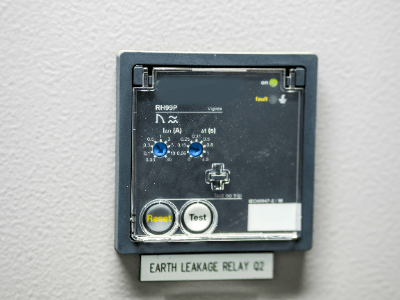What Is an Earth Leakage Relay?
 An earth leakage relay is a mechanical device used to detect the presence of leakage current in an electrical circuit.
An earth leakage relay is a mechanical device used to detect the presence of leakage current in an electrical circuit.
They are also called ground fault relays. Electric circuits are generally insulated from the surrounding environment by insulating resins such as polyethylene or vinyl.
When a part of an electric circuit comes into contact with a conductive object due to damage to the insulation and electricity flows, this is called leakage current. Accidentally touching a leaky electric circuit or surrounding metal can cause an electric shock to the human body, resulting in personal injury. If electricity travels through the steel frame of a building, it can also cause a fire, so care must be taken.
The use of earth leakage relays to cut off the power supply or to issue an alarm prevents the above phenomena.
Uses of Earth Leakage Relays
Earth leakage relays are used in many electrical circuits. The following are examples of applications of earth leakage relays:
1. Ground-Fault Circuit Breakers
RCDs are devices that automatically shut off the power supply when a leakage is detected. RCDs are generally used in low-voltage circuits and are also installed inside distribution boards for home use.
2. Inside a Cubicle
A cubicle is an enclosure for power supply and demand with a high-voltage transformer and circuit breaker built inside, and is used in supermarkets and public facilities. Inside the cubicle, leakage current fire alarms and other devices are built in to detect leakage currents at an early stage.
3. For Controlling Gas-Insulated Switchgear (GIS) And Vacuum Circuit Breakers in Substations
Substations handle electricity at voltages higher than high voltage, so vacuum circuit breakers are used to energize and disconnect the electricity. Since these devices do not have a function to detect leakage current, they are controlled by a combination of Earth Leakage Relays.
Principle of Earth Leakage Relay
There are several principles by which earth leakage relays can detect leakage current.
1. In the Case of Direct Current
When DC voltage is the target, there is a method of detecting the voltage to ground. Generally, the middle point between the two terminals of a DC circuit is 0 V to ground, but when a leakage current occurs, the ground-faulted wiring terminal side becomes 0 V to ground. Therefore, leakage current can be detected by measuring the ground voltage at both terminals.
2. In the Case of Alternating Current
In the case of alternating current, it can also be detected by measuring the reciprocating current. In general, the sum of the reciprocating currents in an electric circuit is equal, but when a ground fault occurs and a current flows between the two terminals, the sum of the reciprocating currents is not equal. Therefore, leakage current can be detected by measuring the round-trip current and checking if it is balanced.
3. Zero-Phase Current
There are other methods to measure zero-phase current. Magnetic fields are always generated around cables carrying alternating current, but they are characterized by the fact that they cancel each other outward and inward.
When a ground fault occurs, one of the magnetic fields becomes stronger than the other, so they can no longer completely cancel each other out, resulting in a zero-phase current due to the magnetic field. By checking this zero-phase current, leakage current can be detected.
Types of Earth Leakage Relays
There are two main types of earth leakage relays: non-directional and directional. Both types of relays use a zero-phase current transformer to measure the zero-phase current to determine if there is a leakage current and send a leakage current signal to the circuit.
1. Non-Directional Earth Leakage Relay
This is a mechanism to detect the accident current in case of leakage current by a zero-phase current transformer. It is also called a ground relay.
Currents in a three-phase AC circuit are divided into three types: positive-phase current flowing in the positive direction on each line, reverse-phase current flowing in the reverse direction, and zero-phase current flowing in the same phase. Since zero-phase current flows in the case of leakage current, leakage current can be checked with a zero-phase current transformer.
The non-directional type only checks for ground faults, so there is a risk of malfunction if a ground fault occurs in the upper system, etc.
2. Directional Earth Leakage Relay
This system detects the fault current in the event of a ground fault by means of a zero-phase current transformer and a zero-phase voltage detector. It is also called a directional ground relay.
A zero-phase voltage detector is a device that detects zero-phase voltage by means of a capacitor inside the device. The zero-phase voltage is normally 0 V, but a voltage is generated in the event of a ground fault.
This voltage is divided by a series-connected square-phase capacitor and a detection capacitor, and the voltage across the detection capacitor is further reduced by a transformer. The earth fault direction relay detects the direction of the earth fault. Therefore, it does not malfunction when a ground fault occurs in the upper system, but only interrupts the ground fault that occurs in its own system.